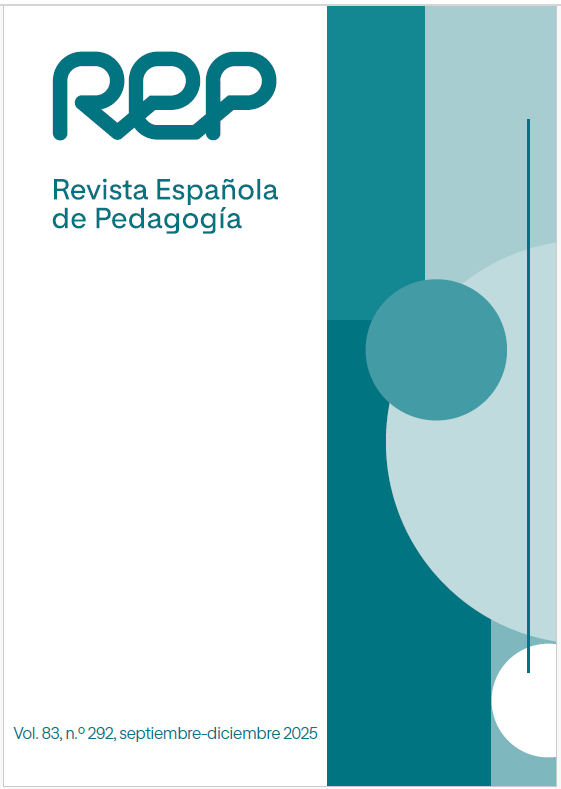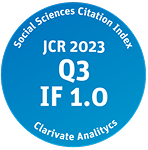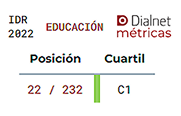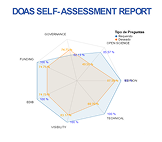El efecto del entorno de aprendizaje en las competencias digitales y de sostenibilidad autopercibidas de los estudiantes
DOI:
https://doi.org/10.9781/rep.2025.389Palabras clave:
entorno de aprendizaje, competencias de sostenibilidad, competencias digitales, educación, resultados de aprendizaje, autoevaluaciónResumen
Este estudio investiga el efecto de las percepciones de los alumnos del entorno de aprendizaje en sus competencias digitales y de sostenibilidad según su propia autoevaluación. En el estudio participaron 433 alumnos de último curso de programas educativos de Ciencia y Tecnología de la Madera de Eslovenia. Distinguimos entre competencias genéricas, que pueden evaluarse con los marcos DigComp y GreenComp, y competencias específicas de la profesión. Los factores del entorno de aprendizaje se evaluaron utilizando el cuestionario «What Is Happening in This Class?» o WIHIC (¿Qué está pasando en esta clase?). El análisis de regresión lineal reveló que el factor ‘Investigación’ predecía tanto competencias digitales y de sostenibilidad genéricas como específicas de la profesión, y que ‘Implicación’ predecía competencias digitales genéricas, mientras que ‘Apoyo del profesor’ tenía un efecto negativo en las competencias digitales y de sostenibilidad genéricas. Las pruebas t pareadas mostraron discrepancias significativas entre el entorno de aprendizaje real y el entorno preferido por los alumnos. Los resultados destacan la importancia de promover el aprendizaje activo y basado en la investigación, apoyando la autonomía del alumno y la individualización, y de tener en cuenta las preferencias de los alumnos respecto al entorno del aprendizaje para facilitar un mejor desarrollo de sus competencias digitales y de sostenibilidad.
Descargas
Citas
Ahačič, K., et al. (2024). Skupni cilji in njihovo umeščanje v učne načrte in kataloge znanj. Zavod Republike Slovenije za šolstvo. www.zrss.si/pdf/skupni_cilji.pdf
Aldridge, J. M., Fraser, B. J., y Huang, T.-C. I. (1999). Investigating Classroom Environments in Taiwan and Australia with Multiple Research Methods. The Journal of Educational Research, 93(1), 48-62. http://www.jstor.org/stable/27542246
Ali, N., Abu Khurma, O., Afari, E., y Swe Khine, M. (2023). The influence of learning environment to students' non-cognitive outcomes: Looking through the PISA lens. Eurasia Journal of Mathematics, Science and Technology Education, 19(3), em2233. https://doi.org/10.29333/ejmste/12967
Allen, D., y Fraser, B. J. (2007). Parent and student perceptions of classroom learning environment and its association with student outcomes. Learning Environments Research, 10(1), 67-82. https://doi.org/10.1007/s10984-007-9018-z
Bandura, A. (1997). Self-Efficacy: The Exercise of Control. W. H. Freeman.
Bianchi, G., Pisiotis, U., y Cabrera Giraldez, M. (2022). GreenComp The European sustainability competence framework. In Luxembourg: Publications Office of the European Union.
Blais, M.-C., Gauchet, M., y Ottavi, D. (2011). O pogojih vzgoje. Formatisk.
Bloom, B. S. (1976). Human characteristics and school learning. McGraw-Hill.
Bonwell, C. C., y Eison, J. A. (1991). Active Learning: Creating Excitement in the Classroom (ASHE-ERIC Higher Education Reports, Issue. T. G. W. U). ERIC Clearinghouse on Higher Education.
Brito Santiago, C. F., y Silva, A. B. (2023). Mapping Measurement Scales for the Assessment of Learning Environments. International Education Studies, 16(2), 164. https://doi.org/10.5539/ies.v16n2p164
Carrió Llach, M., y Llerena Bastida, M. (2023). Exploring innovative strategies in problem based learning to contribute to sustainable development: a case study. International Journal of Sustainability in Higher Education, 24(9), 159-177. https://doi.org/10.1108/ijshe-07-2021-0296
Cayubit, R. F. O. (2022). Why learning environment matters? An analysis on how the learning environment influences the academic motivation, learning strategies and engagement of college students. Learning Environments Research, 25(2), 581-599. https://doi.org/10.1007/s10984-021-09382-x
Cebrián, G., Pascual, D., y Moraleda, Á. (2019). Perception of sustainability competencies amongst Spanish pre-service secondary school teachers. International Journal of Sustainability in Higher Education, 20(7), 1171-1190. https://doi.org/10.1108/ijshe-10-2018-0168
Chaikovska, H., Levchyk, I., Adamska, Z., y Yankovych, O. (2024). Formation of sustainable development competencies in Ukrainian English for specific purposes students. International Journal of Sustainability in Higher Education, 25(4), 744-766. https://doi.org/10.1108/IJSHE-07-2023-0306
Chaudhary, P., y Singh, R. K. (2022). A Meta Analysis of Factors Affecting Teaching and Student Learning in Higher Education. Frontiers in Education, 6. https://doi.org/10.3389/feduc.2021.824504
Chionh, Y. H., y Fraser, B. J. (2009). Classroom environment, achievement, attitudes and self-esteem in geography and mathematics in Singapore. International Research in Geographical and Environmental Education, 18(1), 29-44. https://doi.org/10.1080/10382040802591530
Clifton, R. A., Perry, R. P., Stubbs, C. A., y Roberts, L. W. (2004). Faculty Environments, Psychosocial Dispositions, and the Academic Achievement of College Students. Research in Higher Education, 45(8), 801-828. https://doi.org/10.1007/s11162-004-5950-2
Closs, L., Mahat, M., y Imms, W. (2022). Learning environments’ influence on students’ learning experience in an Australian Faculty of Business and Economics. Learning Environments Research, 25(1), 271-285. https://doi.org/10.1007/s10984-021-09361-2
Deci, E. L., y Ryan, R. M. (2000). The "what" and "why" of goal pursuits: Human needs and the self-determination of behavior. Psychological Inquiry, 11(4), 227-268. https://doi.org/10.1207/S15327965PLI1104_01
Dorman, J. P. (2001). Associations Between Classroom Environment and Academic Efficacy. Learning Environments Research, 4(3), 243-257. https://doi.org/10.1023/A:1014490922622
Dorman, J. P., Adams, J. E., y Ferguson, J. M. (2002). Psychosocial Environment and Student Self-Handicapping in Secondary School Mathematics Classes: A cross-national study. Educational Psychology, 22(5), 499-511. https://doi.org/10.1080/0144341022000023590
Draganac, D., Jović, D., y Novak, A. (2022). Digital Competencies in Selected European Countries among University and High-School Students: Programming is lagging behind. Business Systems Research Journal, 13(2), 135-154. https://doi.org/10.2478/bsrj-2022-0019
EC, Centre, J. R., Carretero, S., Vuorikari, R., y Punie, Y. (2017). DigComp 2.1 – The digital competence framework for citizens with eight proficiency levels and examples of use. Publications Office. https://doi.org/doi/10.2760/38842
Festinger, L. (1954). A Theory of Social Comparison Processes. Human Relations, 7(2), 117-140. https://doi.org/10.1177/001872675400700202
Fraser, B., McRobbie, C., y Fisher, D. (1996). Development, validation and use of personal and class forms of a new classroom environment questionnaire. Proceedings Western Australian Institute for Educational Research Forum 1996.
Fraser, B. J. (1998). Classroom Environment Instruments: Development, Validity and Applications. Learning Environments Research, 1(1), 7-34. https://doi.org/10.1023/a:1009932514731
Fraser, B. J., y Fisher, D. L. (1982). Effects of Classroom Psychosocial Environment on Student Learning. British Journal of Educational Psychology, 52(3), 374-377. https://doi.org/10.1111/j.2044-8279.1982.tb02525.x
Fraser, B. J., y Fisher, D. L. (1983). Use of actual and preferred Classroom Environment Scales in person–environment fit research. Journal of Educational Psychology, 75(2), 303-313. https://doi.org/https://doi.org/10.1037/0022-0663.75.2.303
Fraser, B. J., y Treagust, D. F. (1986). Validity and use of an instrument for assessing classroom psychosocial environment in higher education. Higher Education, 15(1), 37-57. https://doi.org/10.1007/BF00138091
Freeman, S., Eddy, S. L., Mcdonough, M., Smith, M. K., Okoroafor, N., Jordt, H., y Wenderoth, M. P. (2014). Active learning increases student performance in science, engineering, and mathematics. Proceedings of the National Academy of Sciences, 111(23), 8410-8415. https://doi.org/10.1073/pnas.1319030111
Galán-Casado, D., Moraleda, A., Martínez-Martí, M. L., y Pérez-Nieto, M. Á. (2020). Sustainable Environments in Education: Results on the Effects of the New Environments in Learning Processes of University Students. Sustainability, 12(7), 2668. https://doi.org/10.3390/su12072668
Gheyssens, E., Griful-Freixenet, J., y Struyven, K. (2023). Differentiated Instruction as an Approach to Establish Effective Teaching in Inclusive Classrooms. In R. Maulana, M. Helms-Lorenz, y R. M. Klassen (Eds.), Effective Teaching Around the World : Theoretical, Empirical, Methodological and Practical Insights (pp. 677-689). Springer International Publishing. https://doi.org/10.1007/978-3-031-31678-4_30
Goh, S. C., Young, D. J., y Fraser, B. J. (1995). Psychosocial Climate and Student Outcomes in Elementary Mathematics Classrooms: A Multilevel Analysis. The Journal of Experimental Education, 64(1), 29-40. https://doi.org/10.1080/00220973.1995.9943793
Goropečnik, L., Makovec Radovan, D., y Kropivšek, J. (2024). Empowering Advancement of Wood and Furniture Sector Through Key Digital and Sustainability Competencies. Drvna industrija, 75(3), 337-347. https://doi.org/10.5552/drvind.2024.0165
Hake, R. R. (1998). Interactive-engagement versus traditional methods: A six-thousand-student survey of mechanics test data for introductory physics courses. American Journal of Physics, 66(1), 64-74. https://doi.org/10.1119/1.18809
Halkos, G., y Gkampoura, E.-C. (2021). Where do we stand on the 17 Sustainable Development Goals? An overview on progress. Economic Analysis and Policy, 70, 94-122. https://doi.org/10.1016/j.eap.2021.02.001
Hao, Q., Barnes, B., y Jing, M. (2021). Quantifying the effects of active learning environments: separating physical learning classrooms from pedagogical approaches. Learning Environments Research, 24(1), 109-122. https://doi.org/10.1007/s10984-020-09320-3
Hatlevik, O. E., Ottestad, G., y Throndsen, I. (2015). Predictors of digital competence in 7th grade: a multilevel analysis. Journal of Computer Assisted Learning, 31(3), 220-231. https://doi.org/10.1111/jcal.12065
He, T., y Li, S. (2019). A comparative study of digital informal learning: The effects of digital competence and technology expectancy. British Journal of Educational Technology, 50(4). https://doi.org/10.1111/bjet.12778
He, T., y Zhu, C. (2017). Digital informal learning among Chinese university students: the effects of digital competence and personal factors. International Journal of Educational Technology in Higher Education, 14(1). https://doi.org/10.1186/s41239-017-0082-x
Heidari, E., Mehrvarz, M., Marzooghi, R., y Stoyanov, S. (2021). The role of digital informal learning in the relationship between students' digital competence and academic engagement during the COVID‐19 pandemic. Journal of Computer Assisted Learning, 37(4). https://doi.org/10.1111/jcal.12553
Jennings, P. A., y Greenberg, M. T. (2009). The Prosocial Classroom: Teacher Social and Emotional Competence in Relation to Student and Classroom Outcomes. Review of Educational Research, 79(1), 491-525. https://doi.org/10.3102/0034654308325693
Joyce, B., y Calhoun, E. (2024). Models of Teaching (10th ed.). Routledge. https://doi.org/10.4324/9781003455370
Kaplan, A., y Flum, H. (2012). Identity formation in educational settings: A critical focus for education in the 21st century. Contemporary Educational Psychology, 37(3), 171-175. https://doi.org/10.1016/j.cedpsych.2012.01.005
Khine, M. S. (2021). David B. Zandvliet and Barry J. Fraser (Eds.): Thirty years of learning environments: Looking back and looking forward (Advances in Learning Environments Research series, Volume 11). Learning Environments Research, 24(3), 537-539. https://doi.org/10.1007/s10984-021-09386-7
Kolb, D. A. (1984). Experiential Learning: Experience As The Source Of Learning And Development (Vol. 1). Prentice Hall.
Krämer, S., Möller, J., y Zimmermann, F. (2021). Inclusive Education of Students With General Learning Difficulties: A Meta-Analysis. Review of Educational Research, 91(3), 432-478. https://doi.org/10.3102/0034654321998072
Laanpere, M. (2019). Recommendations on Assessment Tools for Monitoring Digital Literacy within UNESCO’s Digital Literacy Global Framework (Information Paper No. 56). http://uis.unesco.org/sites/default/files/documents/ip56-recommendations-assessment-tools-digital-literacy-2019-en.pdf
Lambrechts, W., Ghijsen, P. W. T., Jacques, A., Walravens, H., Van Liedekerke, L., y Van Petegem, P. (2018). Sustainability segmentation of business students: Toward self-regulated development of critical and interpretational competences in a post-truth era. Journal of Cleaner Production, 202, 561-570. https://doi.org/10.1016/j.jclepro.2018.07.303
Leal Filho, W., Levesque, V. R., Salvia, A. L., Paço, A., Fritzen, B., Frankenberger, F., Damke, L. I., Brandli, L. L., Ávila, L. V., Mifsud, M., Will, M., Pace, P., Azeiteiro, U. M., y Lovren, V. O. (2021). University teaching staff and sustainable development: an assessment of competences. Sustainability Science, 16(1), 101-116. https://doi.org/10.1007/s11625-020-00868-w
Lewin, K. (1935). A dynamic theory of personality. McGraw-Hill.
Litiņa, S., Miltuze, A., y Svētiņa, K. (2022). Factors influencing digital competence: a focus group study from the perspective of the medical college students. Human, Technologies and Quality of Education, 227-241. https://doi.org/https://doi.org/10.22364/htqe.2022
Liu, C.-J., Zandvliet, D. B., y Hou, I.-L. (2012). The learning environment associated with information technology education in Taiwan: Combining psychosocial and physical aspects. Learning Environments Research, 15(3), 379-402. https://doi.org/10.1007/s10984-012-9120-8
López-Meneses, E., Sirignano, F. M., Vázquez-Cano, E., y Ramírez-Hurtado, J. M. (2020). University students’ digital competence in three areas of the DigCom 2.1 model: A comparative study at three European universities. Australasian Journal of Educational Technology, 36(3), 69-88. https://doi.org/10.14742/ajet.5583
Lozano, R., Barreiro-Gen, M., Lozano, F. J., y Sammalisto, K. (2019). Teaching Sustainability in European Higher Education Institutions: Assessing the Connections between Competences and Pedagogical Approaches. Sustainability, 11(6). https://doi.org/10.3390/su11061602
Lozano, R. et al. (2022). Adopting sustainability competence‐based education in academic disciplines: Insights from 13 higher education institutions. Sustainable Development, 30(4), 620-635. https://doi.org/10.1002/sd.2253
Lucas, M. (2019). Facilitating Students’ Digital Competence: Did They Do It? In Lecture Notes in Computer Science (pp. 3-14). Springer International Publishing. https://doi.org/10.1007/978-3-030-29736-7_1
Makovec Radovan, D. (2025). Načrtovanje in izvajanje kompetenčno zasnovanih programov v poklicnem in strokovnem izobraževanju. Ljubljana: Institute of Vocational education and training.
Mali, D., et al. (2025). Izhodišča za pripravo višješolskih študijskih programov. Center RS za poklicno izobraževanje Retrieved from https://cpi.si/wp-content/uploads/2024/08/A5_Izhodisca-za-pripravo-visjesolskih-studijskih-programov-2025.pdf
Martzoukou, K., Fulton, C., Kostagiolas, P., y Lavranos, C. (2020). A study of higher education students' self-perceived digital competences for learning and everyday life online participation. Journal of Documentation, 76(6), 1413-1458. https://doi.org/10.1108/jd-03-2020-0041
Maslow, A. H. (1943). A theory of human motivation. Psychological Review, 50(4), 370-396. https://doi.org/10.1037/h0054346
McRobbie, C. J., y Fraser, B. J. (1993). Associations Between Student Outcomes and Psychosocial Science Environment. The Journal of Educational Research, 87(2), 78-85. https://doi.org/10.1080/00220671.1993.9941170
Meyer, J. W. (1977). The Effects of Education as an Institution. American Journal of Sociology, 83(1), 55-77. https://doi.org/10.1086/226506
Moos, R. H. (1974). The Social Climate Scales: An Overview. Consulting Psychologists Press. https://books.google.si/books?id=EwZLGQAACAAJ
Moos, R. H., y Trickett, E. (1974). Classroom Environment Scale. Consulting Psychologists Press. https://doi.org/https://doi.org/10.1037/t06449-000
Morin, A. H. (2020). Teacher support and the social classroom environment as predictors of student loneliness. Social Psychology of Education, 23(6), 1687-1707. https://doi.org/10.1007/s11218-020-09600-z
Murray, H. A. (1938). Explorations in personality. Oxford Univ. Press.
MZI. (2024). Nacionalni program vzgoje in izobraževanja za obdobje 2023–2033 - osnutek predloga. Ljubljana: Republic of Slovenia Retrieved from https://www.gov.si/assets/ministrstva/MVI/Dokumenti/Razvoj-solstva/DS-NPVI/Nacionalni-program/Osnutek-predloga-Nacionalnega-programa-vzgoje-in-izobrazevanja-2023-2033.pdf
Olofsson, A. D., y Lindberg, J. O. (2006). “Whatever Happened to the Social Dimension?” Aspects of Learning in a Distance-based Teacher Training Programme. Education and Information Technologies, 11(1), 7-20. https://doi.org/10.1007/s10639-005-5716-2
Ozili, P. K. (2022). The Acceptable R-Square in Empirical Modelling for Social Science Research. SSRN Electronic Journal. https://doi.org/10.2139/ssrn.4128165
Ozturk, I. (2008). The Role of Education in Economic Development: A Theoretical Perspective. SSRN Electronic Journal. https://doi.org/10.2139/ssrn.1137541
Rachinger, M., Rauter, R., Müller, C., Vorraber, W., y Schirgi, E. (2019). Digitalization and its influence on business model innovation. Journal of Manufacturing Technology Management, 30(8), 1143-1160. https://doi.org/10.1108/jmtm-01-2018-0020
Radovan, M., y Makovec, D. (2015). Adult Learners’ Learning Environment Perceptions and Satisfaction in Formal Education—Case Study of Four East-European Countries. International Education Studies, 8(2). https://doi.org/10.5539/ies.v8n2p101
Redman, A., Wiek, A., y Barth, M. (2021). Current practice of assessing students’ sustainability competencies: a review of tools. Sustainability Science, 16(1), 117-135. https://doi.org/10.1007/s11625-020-00855-1
Remington-Doucette, S., y Musgrove, S. (2015). Variation in sustainability competency development according to age, gender, and disciplinary affiliation. International Journal of Sustainability in Higher Education, 16(4), 537-575. https://doi.org/10.1108/IJSHE-01-2013-0005
Rita, R. D., y Martin-Dunlop, C. S. (2011). Perceptions of the learning environment and associations with cognitive achievement among gifted biology students. Learning Environments Research, 14(1), 25-38. https://doi.org/10.1007/s10984-011-9080-4
Romero-García, C., Buzón-García, O., y de Paz-Lugo, P. (2020). Improving Future Teachers’ Digital Competence Using Active Methodologies. Sustainability, 12(18), 7798. https://www.mdpi.com/2071-1050/12/18/7798
Roos, N., Heinicke, X., Guenther, E., y Guenther, T. W. (2020). The Role of Environmental Management Performance in Higher Education Institutions. Sustainability, 12(2), 655. https://doi.org/10.3390/su12020655
Sánchez-Carracedo, F., Romero-Portillo, D., Sureda Carbonell, B., y Moreno-Pino, F. M. (2022). Education for sustainable development in Spanish higher education: an assessment of sustainability competencies in engineering and education degrees. International Journal of Sustainability in Higher Education, 23(4), 940-959. https://doi.org/10.1108/ijshe-02-2021-0060
Savage, E., Tapics, T., Evarts, J., Wilson, J., y Tirone, S. (2015). Experiential learning for sustainability leadership in higher education. International Journal of Sustainability in Higher Education, 16(5), 692-705. https://doi.org/10.1108/ijshe-10-2013-0132
Schauber, S. K., Hecht, M., Nouns, Z. M., Kuhlmey, A., y Dettmer, S. (2015). The role of environmental and individual characteristics in the development of student achievement: a comparison between a traditional and a problem-based-learning curriculum. Advances in Health Sciences Education, 20(4), 1033-1052. https://doi.org/10.1007/s10459-015-9584-2
Schmölz, A., Geppert, C., Schwarz, S., Svecnik, E., Koch, J., Bieg, T., y Freund, L. (2023). Assessing the Second-Level Digital Divide in Austria: A Representative Study on Demographic Differences in Digital Competences. Digital Education Review(44), 61-75. https://doi.org/10.1344/der.2023.44.61-75
Scholkmann, A. (2017). “What I learn is what I like.” How do students in ICT-supported problem-based learning rate the quality of the learning experience, and how does it relate to the acquisition of competences? Education and Information Technologies, 22(6), 2857-2870. https://doi.org/10.1007/s10639-017-9629-7
Schunk, D. H., y Pajares, F. (2002). The Development of Academic Self-Efficacy. In S. E. Allan Wigfield and Jacquelynne (Ed.), Development of Achievement Motivation (pp. 15-31). Academic Press. https://doi.org/10.1016/B978-012750053-9/50003-6
Sillat, L. H., Tammets, K., y Laanpere, M. (2021). Digital Competence Assessment Methods in Higher Education: A Systematic Literature Review. Education Sciences, 11(8), 402. https://www.mdpi.com/2227-7102/11/8/402
Skordi, P., y Fraser, B. J. (2019). Validity and use of the What Is Happening In this Class? (WIHIC) questionnaire in university business statistics classrooms. Learning Environments Research, 22(2), 275-295. https://doi.org/10.1007/s10984-018-09277-4
Skubic Ermenc, K., et al. (2024). Izhodišča za prenovo katalogov znanj za splošnoizobraževalne predmete v poklicnem in strokovnem izobraževanju. Zavod Republike Slovenije za šolstvo Retrieved from www.zrss.si/pdf/izhodisca_za_prenovo_KZ.pdf
Skubic Ermenc, K., Štefanc, D., y Mažgon, J. (2020). Challenges of differentiated and individualized teaching in vocational education: The case of Slovenia. Problems of Education in the 21st Century, 78(5), 815-831. https://doi.org/10.33225/pec/20.78.815
Tanner, C. K. (2008). Explaining Relationships Among Student Outcomes and the School's Physical Environment. Journal of Advanced Academics, 19(3). https://doi.org/10.4219/jaa-2008-812
Tongco, M. D. C. (2007). Purposive Sampling as a Tool for Informant Selection. In (Vol. 5, pp. 147-158): Ethnobotany Research and Applications.
UN. (2015). Transforming our World: The 2030 Agenda for Sustainable Development. In.
UNEP, y IRP. (2024). Global Resources Outlook 2024 - Bend the trend: Pathways to a Liveable Planet as Resource Use Spikes. In.
Verhaeghe, P. (2016). Identiteta (A. Poznič, Ed.). Ciceron.
Vintar Mally, K. (2020). The environmental price of socio-economic development: Worldwide trends from 1990 to 2016. European Journal of Geogrpahy, 11(2), 137-153. https://doi.org/10.48088/ejg.k.mal.11.2.137.153
Vintar Mally, K. (2021). The Performance of European Union Countries in Decoupling Socio-Economic Progress from Environmental Impacts. Dela(54), 105-123. https://doi.org/10.4312/dela.54.105-123
Vlada Republike Slovenije. (2022). Resolucija o nacionalnem programu visokega šolstva do 2030 (ReNPVŠ30). (49/2022). Uradni list Republike Slovenije Retrieved from https://pisrs.si/pregledPredpisa?id=RESO139
Vuorikari, R., Kluzer, S., y Punie, Y. (2022). DigComp 2.2: The Digital Competence Framework for Citizens - With new examples of knowledge, skills and attitudes. In. Luxembourg: Publications Office of the European Union.
Walberg, H. J. (1969). Social environment as a mediator of classroom learning. Journal of Educational Psychology, 60(6, Pt.1), 443-448. https://doi.org/10.1037/h0028499
Walberg, H. J., y Anderson, G. J. (1968). Classroom climate and individual learning. Journal of Educational Psychology, 59(6), 414–419. https://doi.org/10.1037/h0026490
WCED. (1987). Report of the World Commission on Environment and Development: Our Common Future. O. a. N. Y. O. U. Press.
Weinstein, C. S. (1981). Classroom Design as an External Condition for Learning. Educational Technology archive, 21, 12-19.
Whitley, C. T., Takahashi, B., Zwickle, A., Besley, J. C., y Lertpratchya, A. P. (2018). Sustainability behaviors among college students: an application of the VBN theory. Environmental Education Research, 24(2), 245-262. https://doi.org/10.1080/13504622.2016.1250151
Xu, J., She, S., y Liu, W. (2022). Role of digitalization in environment, social and governance, and sustainability: Review-based study for implications. Frontiers in Psychology, 13. https://doi.org/10.3389/fpsyg.2022.961057
Zandvliet, D. B., y Fraser, B. (2018). Thirty Years of Learning Environments: Looking Back and Looking Forward. Brill. https://doi.org/10.1163/9789004387720
Zandvliet, D. B., y Straker, L. M. (2001). Physical and psychosocial aspects of the learning environment in information technology rich classrooms. Ergonomics, 44(9), 838-857. https://doi.org/10.1080/00140130117116
Zhao, Y., Pinto Llorente, A. M., y Sánchez Gómez, M. C. (2021). Digital competence in higher education research: A systematic literature review. Computers & Education, 168(104212). https://doi.org/10.1016/j.compedu.2021.104212
Zhao, Y., Sánchez Gómez, M. C., Pinto Llorente, A. M., y Zhao, L. (2021). Digital Competence in Higher Education: Students’ Perception and Personal Factors. Sustainability, 13(21). https://doi.org/10.3390/su132112184
Zsóka, Á., Szerényi, Z. M., Széchy, A., y Kocsis, T. (2013). Greening due to environmental education? Environmental knowledge, attitudes, consumer behavior and everyday pro-environmental activities of Hungarian high school and university students. Journal of Cleaner Production, 48, 126-138. https://doi.org/10.1016/j.jclepro.2012.11.030
Descargas
Publicado
-
Resumen934
-
PDF (English)228
-
PDF98
Cómo citar
Número
Sección
Licencia
Derechos de autor 2025 Luka Goropečnik

Esta obra está bajo una licencia internacional Creative Commons Atribución-NoComercial 4.0.











